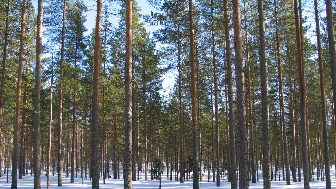Policy Brief
Decreasing deforestation and increasing afforestation would help Finland achieve climate commitments

According to the recent study, decreasing deforestation and increasing afforestation are justified measures to mitigate climate change, although compared to the forest sink the effects of these measures are relatively small in Finland. From the perspective of climate, the most beneficial would be to decrease the deforestation on peatlands.
The achievement of climate commitments requires measures which reduce greenhouse gases and enhance the carbon sinks in all sectors. More specifically, the LULUCF accounting rules for 2021–2030 increase the relative importance of decreasing deforestation and increasing afforestation as their emissions and removals are fully taken into account, contrary to forest sink.
According to the recent study on potential of land use measures in climate change mitigation, decreasing deforestation is generally more beneficial for the climate than afforestation, and especially so in peatlands. Afforestation can be profitable especially on low productive agricultural land in Northern Finland with thick peat layer. In these areas, the climate benefit of afforestation, estimated as an annual emission reduction by afforestation using the price of emissions trading, is equal to the recorded average rent level of agricultural land in that region.
Achieving the climate commitments demands effective policy instruments
Reaching the long-term emission reduction targets in the land use sector requires the effective policy instruments which are available beyond the EU’s programme periods. For example, deforestation for agricultural or urban development purposes can be effectively prevented by setting a fee for the land use change. The need to convert forest to agricultural land can also be reduced by developing and applying improved manure management and processing solutions. Encouraging cooperation between farms can improve the utilisation of existing agricultural land and thus, prevent the further deforestation.
Afforestation can be promoted through financial support. The introduction of financial support for afforestation should, however, be followed by measures for preventing deforestation. Otherwise, the policy may instigate afforestation in one area and unwanted deforestation in another. Typical afforestation areas in Finland include abandoned agricultural land, grassland and peat production areas.
It should be kept in mind that some measures of the current agri-environmental support scheme already promote the reduction of greenhouse gas emissions. Among those the largest emission reduction in relative terms can be achieved by increasing the proportion of grass covered fields, and by raising the groundwater level on cultivated peatland fields.
Potential of land use measures in climate change mitigation (MISA) project is a part of the implementation of the 2018 Government plan for analysis, assessment and research.
Policy Brief: https://tietokayttoon.fi/julkaisu?pubid=30401
Further information from the Ministry of Agriculture and Forestry of Finland:
Ministerial Adviser Jaana Kaipainen, tel. +358 29 516 2270, [email protected]
Ministry of Agriculture and Forestry of Finland, [email protected]
Further information from the Natural Resources Institute Finland:
MISA project: research professor Tuula Packalen, tel. +358 29 532 5351
Policy instruments in agriculture: research professor Heikki Lehtonen, tel. +358 29 532 6316
Policy instruments in forestry: research professor Jussi Uusivuori, tel. +358 29 532 5505
Optimisation of agricultural land use: research professor Pirjo Peltonen-Sainio, tel. +358 29 532 6433
Effects of measures in the land-use sector on greenhouse gas emissions: research professor Kristiina Regina, tel. +358 29 532 6474
Email addresses: [email protected]


